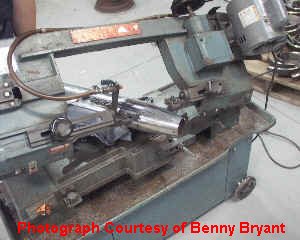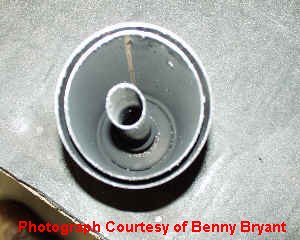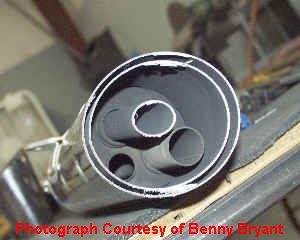To remove the double wall ring, I first made a very sharp chisel out of an old flat blade screwdriver. I ground the flat blade to a sharp edge with the Dremel tool using the flat side of a cut off wheel. The spot welds holding the wall to the baffle plate are evenly spaced at 90 degree intervals around the perimeter of the ring. The diagram above shows the spot welds but the exact orientation may differ from muffler to muffler. The diagram is for illustration purposes only and is not in scale detail. Notice that the 'Cut Here' mark is located exactly between two of the spot weld positions. Use the chisel, starting on the ring's edge and between two of the spot welds, to cut the ring from the outside edge down to the baffle plate. Cut the ring in four places so that you have four large tabs, each held in place to the baffle plate by the spot weld at the bottom center of each tab. Grab each tab in turn with needle nose vise grips, and wiggle back and forth until the tab breaks off at the spot weld. What you should be left with is four barely noticeable spot welds on the baffle plate. Be careful when cutting the ring with the chisel that you don't cut or gouge the main muffler wall.
You're almost done! I cleaned up the slash cut with a small file and a couple of different grades of emery cloth. Use very fine emery cloth to smooth the main wall edges and to sand smooth and clean the exposed areas inside the muffler. Since I side slashed mine, I painted the baffle plate with high temp black and the exposed main muffler walls with aluminum high temp.
The first time I started up the bike after slashing the pipes, I was very pleased with the sound but it still had a high pitched bark or cracking sound to it. So,... I attached ender washers to the front of the baffle plate, over the holes directly in front of the Inner Exhaust Pipes that I had cut off and removed. I used large toggle bolts behind the baffle plate to hold the fender washers in place. The threads of the screws into the toggle bolts were gooped with high temp RTV to act as thread lock to keep the washers and toggle bolts in place. This made a *big* difference in the sound. The problem was that the exhaust gasses were still blowing out the back, directly through the hole left in the baffle plate after removing the section of Inner Exhaust Pipe, and by plugging the hole, the exhaust has more time to expand before exiting the muffler. This part is strictly a matter of taste. I put the fender washers in after re-installing the exhaust system and checking it out. A little paint on the washers and they disappear,... well almost anyway!
Some have experimented with fine tuning the sound by using additional fender washers on one or both of the 1/2" baffle redirection ports. You MUST leave the final exhaust pipe hole open. If you plug both of the large holes, the pipes will become too restrictive.
 |
|
Finished product. The fender washers and the baffle plates were painted with high temp black and the muffler walls were air brushed with high temp aluminum.
|
A couple of others, Harold Parsons and Ed Clarke have come up with a few variations on the semi-gut process. Their innovations have made the procedure easier. Although I haven't heard their pipes, they (and others who have followed suit) are extremely pleased with the results.
Harold and Ed didn't cut the inner exhaust pipe off inside the inner baffle chamber as I did. Instead, they cut the inner exhaust pipe off close to the second baffle plate and then plugged the inner exhaust pipe with a 1" automotive freeze plug. Harold spot welded the freeze plug in the inner exhaust pipe, while Ed used Liquid Steel epoxy to anchor the plug. They then used a 12" long, 1/2" diameter drill bit inserted through the holes in the second baffle plate to drill 4, 1/2" holes in the third baffle plate. The long drill bit can be found at Home Depot or the like. Drill at least 4, 1/2" holes in the baffle plate.
Ed also used Liquid Steel to fill the gap between the Double Body Wall and the main muffler wall. Rather than remove the double wall, he ended up with a 1/8" thick muffler wall at the slash end.
To re-jet or not to re-jet,...that is the question!
If you've already re-jetted for an air box mod such as the RAK, BAK, GAK, Thunder, etc, you won't have to touch a thing. If you are stock and you do the modification as described, you probably will not have to re-jet either. This mod does NOT significantly reduce back pressure through the exhaust. It all depends on if your bike is running on the lean side already. I don't know of ANYONE who has had to re-jet as a result of this mod. The only way to know for sure however, is to monitor closely for the first few hundred miles. CHECK YOUR PLUGS or have the exhaust checked by your mechanic!!
I hope you enjoy the results. I certainly do! It's a little work to do this modification but the results are awesome. I really like both the looks and the sound of the slash cut stock pipes. As a side benefit, my local mechanic (not a Yamaha dealer) told me that the stock exhaust system would last up to three times longer and was much better quality than many aftermarket systems. I don't know if this is true, but it was nice to hear.
If you'd like to see some other rides with slash cut stockers, click on the thumbnail images below. You'll get a pop up window with a larger picture. Just close the window when you're done. The first bike belongs to Lance Brannon, the second belongs to Harold Parsons and the third belongs to Floyd Lawler.
Thanks also go to all those who have designed, tested, provided feedback, enhanced or in any way helped with the development of this modification.
Ron |















